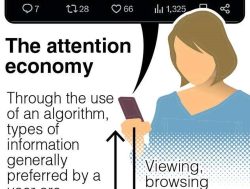Okinawa 50 years since return / Largest market undergoes change, but retains importance
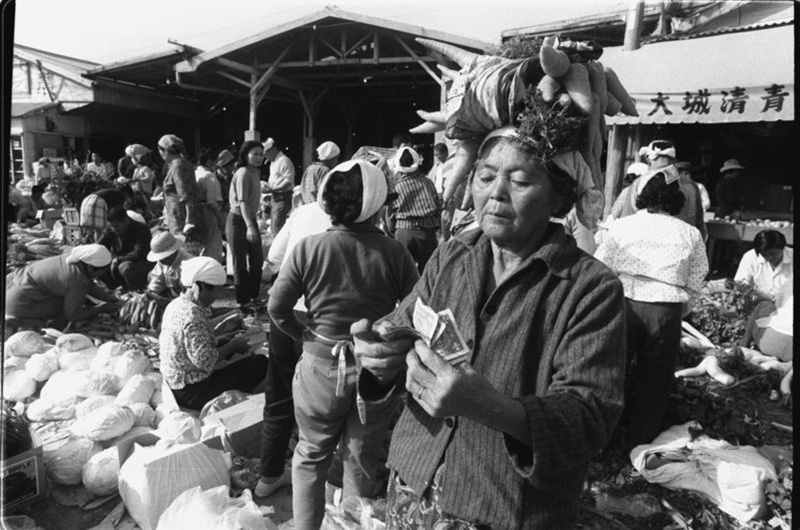
An intermediate wholesaler with a dozen or so radishes on her head counts dollar bills amid the raucous negotiations between buyers and sellers at the Noren Central Market in April 1972.
The Yomiuri Shimbun
14:02 JST, January 3, 2022
In this series, we mark the 50th anniversary of Okinawa’s return to Japan by looking at its past and present through photographs.
Seen from the outside, the modern Noren Plaza shopping center in Naha shows no hints of the thriving outdoor market that occupied the site decades ago.
Shown a photo of the Noren Central Market taken at the time of Okinawa’s return to Japan in 1972, Kiku Aragaki smiles as she recalls memories of the place where she starting working as an intermediate wholesaler in 1958.
“As I was still young, I used to carry a load of vegetables on top of my head, and I was pretty good at it,” said Aragaki, who at 95 is still going strong in her shop on the first floor of the Noren Plaza.
The Ryukyu Noren (now JA Okinawa) market that opened in 1953 originated from the black market that developed after World War II. Farmers would sell their produce to intermediate wholesalers, who sold it at what became known as “the kitchen of the Okinawans.”
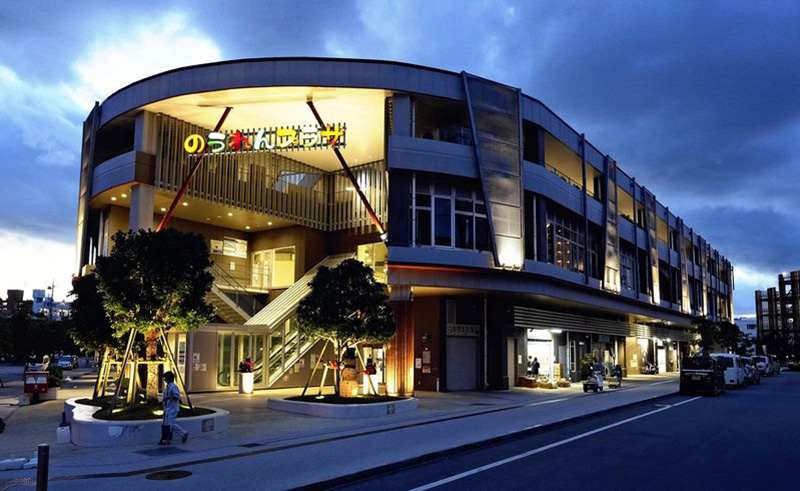
The three-story Noren Plaza was built in a corner of the former Noren Central Market site.
Aragaki remembers the market of a half-century ago as if it were yesterday. “When there was a shortage of goods, it would cause prices to go up, which was fun because it also meant bigger profits.” She recalls it getting so crowded there would be no place to step.
Back in 1972 as Okinawa prepared for the change in sovereignty, Tsuyoshi Akamine started working at her parents’ shop in the market. Now the owner, the 71-year-old remembered those halcyon days.
“Customers in trucks would roll in from every corner of Okinawa island, from Yambaru [in the north] to Itoman [in the south] to make purchases,” Akamine said. “We were too busy to even exchange greetings.”
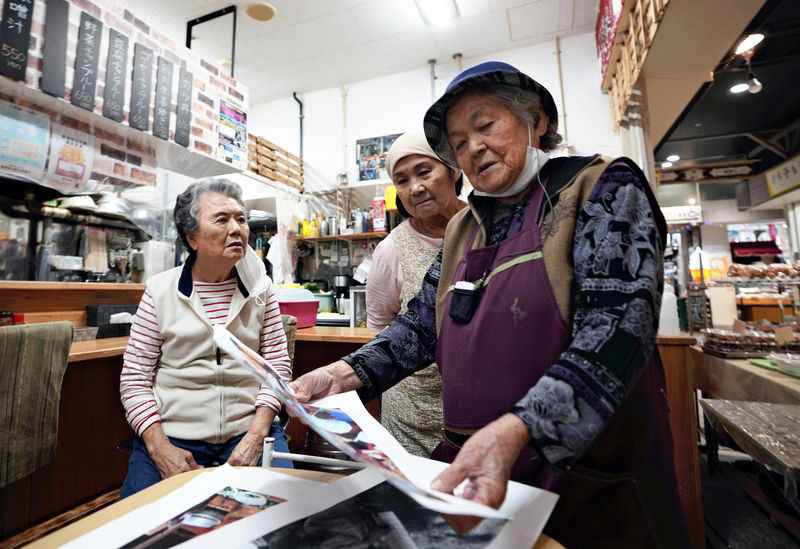
Kiku Aragaki, still an active intermediate wholesaler at 95, looks at photos taken around the time of Okinawa’s return to Japan at Noren Plaza in Naha on Dec. 3.
Liquor and canned goods flew off the shelves in a time of great prosperity.
“We used to iron and stretch out dollar bills and yen bills that had got crumpled because we stuffed them into rice bags.”
The market remained the largest on the island of Okinawa from the time of U.S. rule to the mid-1980s. It was the major distribution center drawing together farmers and intermediaries from all over Okinawa.
One of the features was that prices were set by direct negotiations between sellers and buyers, instead of through auctions. These transactions also made the market a social gathering place where information from all over the island could be disseminated.

Yukie Uehara, right, sells her spinach and komatsuna spinach to a regular customer.
However, over the past half-century, auction markets developed and direct sales spots sprung up all over the island. Supermarkets and convenience stores, which lagged behind the rest of Japan, started arriving. As systemized distribution took hold, more and more vendors left the market and it lost its vitality.
In 2017, the market was moved to a building constructed as part of a redevelopment of the area. About 100 businesses — 26 members of the market’s cooperative and other enterprises such as restaurants and souvenir stores — now operate at the site.
At the time of Okinawa’s return, about 300 farmers used the facility, but recently with the spread of the coronavirus, only a few show up.
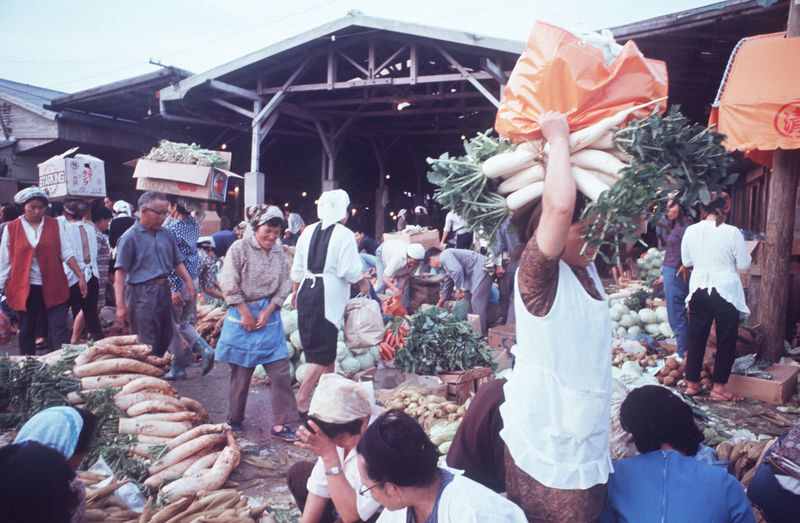
In this photo taken in April 1972 just before Okinawa’s return to Japan, a woman carries a heavy load of vegetables on her head at the Noren Central Market.
However, some of the old-fashioned ways of trading still go on. Yukie Uehara, a 72-year-old farmer from Tomigusuku, started coming a few years after Okinawa’s return to Japan. Now on weekdays, she brings komatsuna spinach and other vegetables and takes in about ¥20,000 a day.
“With this way of negotiated trading, I can always find a buyer for what I’ve grown,” she said. “Without this place, I’d have no means of living,” she adds before heading home, toting a boxed lunch she bought at the plaza.
The market may have lost some of its mojo, but there are still livelihoods relying on it.
Popular Articles
Popular articles in the past 24 hours
-

Diplomacy with Central Asia: Utilize Long-Established Relationshi...
-

Poll Finds High Approval Rating for PM Takaichi’s Economic Measur...
-

Japan Actor Ryoko Hirosue Given Summary Indictment over Car Accid...
-

Japanese Actors Haru, Mahiro Takasugi Announce Marriage
-

Japan Shares Rise as Bond Yields Retreat; Tech Jitters Weigh on N...
-

9 Japanese Police Officers Suspected of Online Casino Gambling
-

Hepburn Romaji Deemed Standard for Japanese Words, Names; Change ...
-

Hakone Ekiden Banners Hung at Tokyo's JR Shinagawa Station Ahead ...
Popular articles in the past week
-

Israeli Tourists Refused Accommodation at Hotel in Japan’s Nagano...
-

U.S. Senate Resolution Backs Japan, Condemns China's Pressure
-

Sharp Decline in Number of Chinese Tourists But Overall Number of...
-

Japan Set to Participate in EU's R&D Framework, Aims to Boost Coo...
-

China Attacks Japan at U.N. Security Council Meetings; Representa...
-

Japan Backs Public-Private Cooperation on Economic Security; Nati...
-

As Chinese Tourists Shun Japan, Hotels and Stores Suffer
-

Bus Bound for Hokkaido's New Chitose Airport Catches Fire Wednesd...
Popular articles in the past month
-

Tokyo Economic Security Forum to Hold Inaugural Meeting Amid Tens...
-

Keidanren Chairman Yoshinobu Tsutsui Visits Kashiwazaki-Kariwa Nu...
-

Imports of Rare Earths from China Facing Delays, May Be Caused by...
-

University of Tokyo Professor Discusses Japanese Economic Securit...
-

Japan Pulls out of Vietnam Nuclear Project, Complicating Hanoi's ...
-

Govt Aims to Expand NISA Program Lineup, Abolish Age Restriction
-

Blanket Eel Trade Restrictions Rejected
-

Key Japan Labor Group to Seek Pay Scale Hike
"Society" POPULAR ARTICLE
-

M4.9 Earthquake Hits Tokyo, Neighboring Prefectures
-

Israeli Tourists Refused Accommodation at Hotel in Japan’s Nagano Pref., Prompting Protest by Israeli Embassy and Probe by Prefecture
-

M7.5 Earthquake Hits Northern Japan; Tsunami Waves Observed in Hokkaido, Aomori and Iwate Prefectures
-

Tsukiji Market Urges Tourists to Avoid Visiting in Year-End
-

High School in Kyoto Says Students Shoplifted during Recent School Trip to Bali, Indonesia
JN ACCESS RANKING
-

Tokyo Economic Security Forum to Hold Inaugural Meeting Amid Tense Global Environment
-

Keidanren Chairman Yoshinobu Tsutsui Visits Kashiwazaki-Kariwa Nuclear Power Plant; Inspects New Emergency Safety System
-

Imports of Rare Earths from China Facing Delays, May Be Caused by Deterioration of Japan-China Relations
-

University of Tokyo Professor Discusses Japanese Economic Security in Interview Ahead of Forum
-

Japan Pulls out of Vietnam Nuclear Project, Complicating Hanoi’s Power Plans



